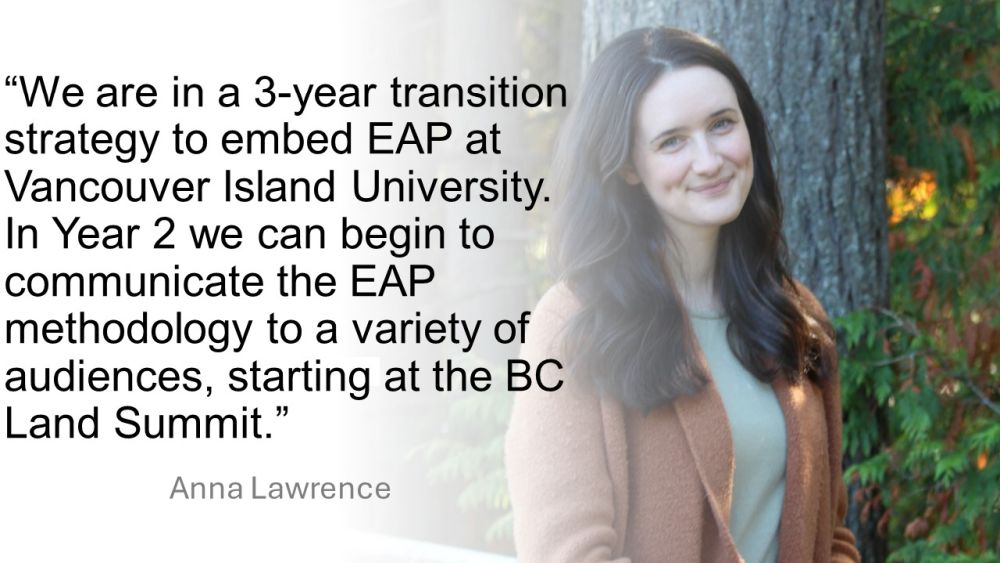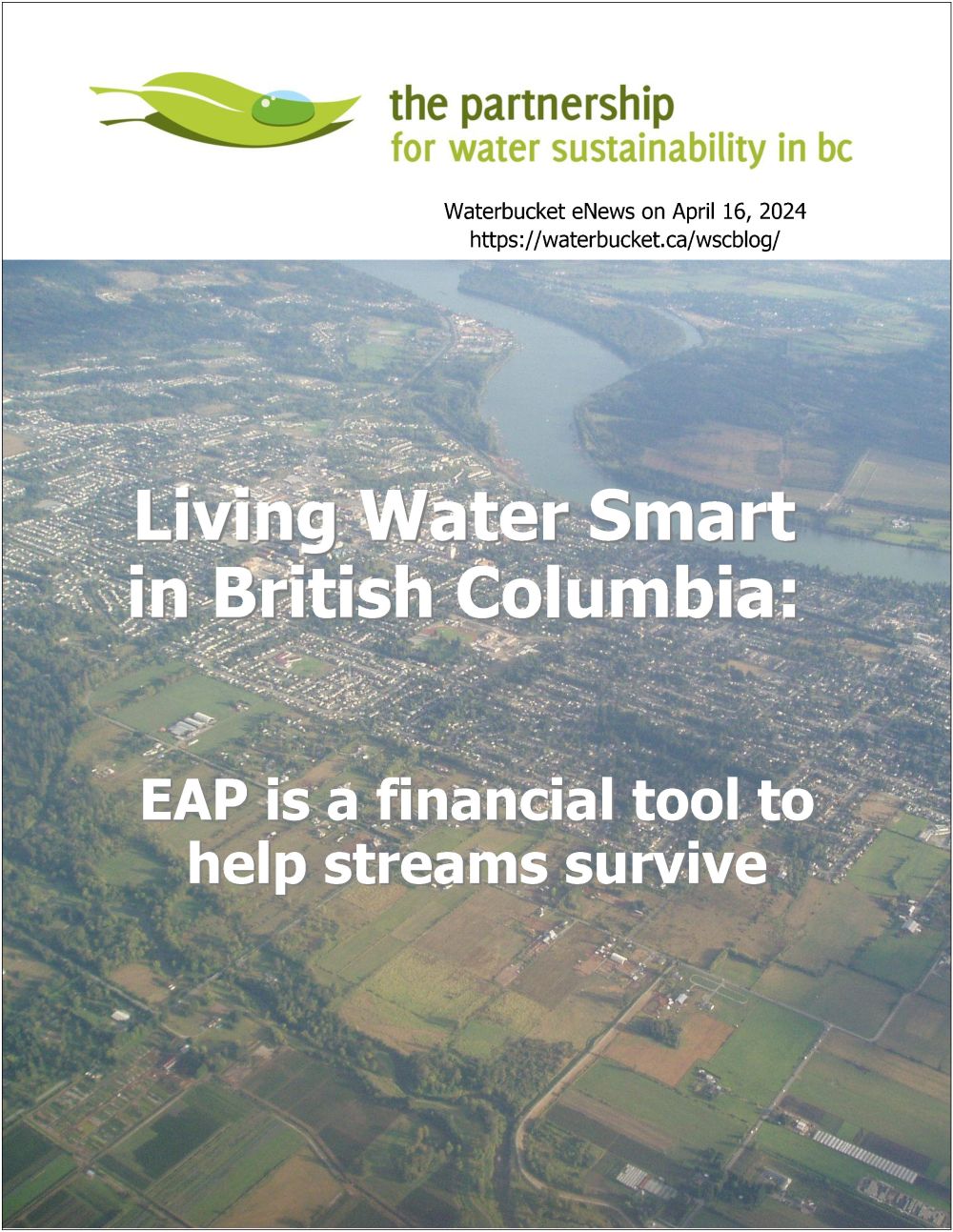EAP, THE ECOLOGICAL ACCOUNTING PROCESS, IS A FINANCIAL TOOL TO HELP STREAMS SURVIVE: “We are in a 3-year transition strategy to embed EAP at Vancouver Island University. We can see the many directions EAP could take,” stated Anna Lawrence, Project Coordinator, Mount Arrowsmith Biosphere Region Research Institute at VIU
Note to Reader:
Published by the Partnership for Water Sustainability in British Columbia, Waterbucket eNews celebrates the leadership of individuals and organizations who are guided by the Living Water Smart vision. The edition published on April 16, 2024 features Tim Pringle, Anna Lawrence, and Sam Gerrand who personify the passing of the intergenerational baton.
They tell the story of Year One of the 3-year transition strategy to embed EAP, the Ecological Accounting Process, at Vancouver Island University. EAP is a financial tool that fills a gap. It provides a measure of the Riparian Deficit which is a consequence of urbanization.

EAP is a financial tool to help streams survive
At the BC Land Summit on May 9 in Nanaimo, Tim Pringle will tag-team with Anna Lawrence and Sam Gerrand to tell the story of Year One of the 3-year transition strategy to embed EAP, the Ecological Accounting Process, at Vancouver Island University (VIU). For a session overview, CLICK HERE.
Because local government Asset Management Plans need real financial values, EAP fills a gap. It allows local governments to establish affordable annual budgets for stream maintenance and management. This moves the budget-setting process beyond rhetoric and into “the realm of the substantive”.

Going beyond doing just enough
Human settlement degrades stream systems. A series of reports by the Ombudsperson link weak oversight of riparian areas regulation to continuing degradation. Meanwhile, the pressure on governments to pave the way for housing is seemingly relentless. So, how do communities find a balance between these competing realities?
How will we course correct to find the balance that achieves a desired outcome such as: create liveable communities and protect stream health? The vision for the EAP Partnership is to continuously train the next generations of local government staffs and build capacity to get the job done.
“I came into the EAP process with a completely different background because my master’s degree is in Sustainable Leisure Management,” states VIU’s Anna Lawrence who is being mentored by Tim Pringle as part of the intergenerational baton strategy.
“So, it was a journey to get my head around the jargon and the different viewpoints and ways of thinking. This applied not only to the development of the EAP methodology but also to the different stakeholders.”

Why we need EAP, the Ecological Accounting Process, to tackle the “Riparian Deficit”
“In the 1990s, research by Richard Horner and Chris May at the University of Washington shook the foundations of traditional engineering practice and provided us with a science-based framework for understanding what stream system integrity means. We had our starting point for the goal of balancing use and conversation of land,” stated Kim Stephens, Waterbucket eNews Editor and Partnership Executive Director.
“With publication of Beyond the Guidebook 2015, Tim Pringle and I framed water balance accounting and ecological accounting as the Twin Pillars of Stream System Integrity for a whole-system approach to assessing changes in hydrology and the riparian deficit, respectively. This launched the EAP journey!”

“Under Tim Pringle’s direction, we completed 9 case studies in collaboration with 13 local government partners in 5 regions of southwest BC. We also built a relationship with the Mount Arrowsmith Biosphere Research Institute (MABRRI) at Vancouver Island University and involved students in the data analysis and GIS work. In fact, we relied on students.”
“With release of the EAP Synthesis Report in 2022, the timing was right to embed our EAP knowledge at MABRRI, launch the EAP Partnership, and begin training next generations of local government staff to tackle the Riparian Deficit. Multi-year commitments by local governments to build capacity and co-funding by UBCM make this possible,” concluded Kim Stephens.
Riparian Deficit explained
“A measure of the consequence of human settlement is the Riparian Deficit,” explains Tim Pringle, Chair of the Ecological Accounting Process (EAP) initiative.
“The Riparian Deficit applies to the regulated setback which is the interface between land and a stream. It is the natural systems equivalent of the well-known Infrastructure Deficit for engineered systems.”

“EAP is a land use perspective. EAP provides local governments with the real numbers they need to deliver outcomes: What is the number for the line item in a local government annual budget for community investment in maintenance and management, that is M&M, of streams?”
“Streams need a place to be. If we cannot get our heads around that, we are not going to keep our streams. When something does not get measured, it does not get managed,” Tim Pringle stresses.
To Learn More:
To read the complete story, download a copy of Living Water Smart in British Columbia: EAP is a financial tool to help streams survive.
DOWNLOAD A COPY: https://waterbucket.ca/wcp/wp-content/uploads/sites/6/2024/04/PWSBC_Living-Water-Smart_EAP-Partnership-and-intergenerational-baton_2024.pdf


